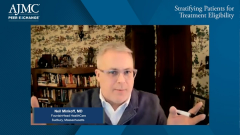
Increased Prevalence of Alzheimer Disease
Experts in the management of Alzheimer disease consider the increased prevalence of Alzheimer disease in the United States with growing geriatric populations and how the health care system is adapting.
Episodes in this series

Neil Minkoff, MD: This is something that is not going away. This is going to keep growing, as a public health issue and a problem that we all have to deal with, whether it is the health plan, family members, diagnosticians, and so on. From your research, can you comment on what you expect is going to be the trajectory here and what we are going to be seeing in terms of prevalence moving forward?
Mona Chitre, PharmD: Absolutely. In our population, in our communities, there is not 1 person who has not been impacted by Alzheimer disease. I appreciate the analogy of domestic terrorism and cancer of the brain because it is truly a devastating disease. We have a baby boomer population. We are aging. We looking at not only Alzheimer disease but also mild cognitive impairment.
RAND Corp published a study in 2017 that looked at a simulation analysis of our population as it gets older, and we perhaps start to have better identification of the disease and treatments. It analyzed what the health care infrastructure will look like, and I will say that we have some opportunities. At the current rate, it would take a patient about 18 months to get to the appropriate caregiver. As was mentioned already, there is so much personal and family stigma of taking that first step and getting into the physician’s office. And getting into the right physician’s office is so important. I am sure we see this in our region [in New York] and perhaps across the country. The study suggested that we have some challenges with appropriate providers: those that can administer those diagnostic tools, who truly know when to use them and how to use them.
As we move forward and learn more about the disease, as Dr Michael Cantor mentioned, how can we test these patients for the appropriate diagnosis? Ultimately, as Dr Richard Isaacson mentioned, we will hopefully have some new drugs coming shortly. What happens with our home-infusion system? What happens with our drug-delivery capabilities? The good thing is that we are looking at it in everything from mild cognitive impairment all the way to Alzheimer disease and where there are opportunities within the system to start closing those gaps.
Neil Minkoff, MD: One of the things that is an interesting juxtaposition or dichotomy—and maybe I am being naïve—is that there seem to be fewer and fewer diseases going forward where there is so much stigma or so much concern. I am assuming, Mr Gasby, that you were afraid of the diagnosis, and you mentioned stigma about it. How did that play into the path that you guys went on? I would then like to hear our diagnosticians weigh in on how they have seen other families deal with stigma.
Dan Gasby: I am going to try to bifurcate this into 2 scenarios or situations because my wife and I were public figures and were in entertainment. We were, if I can use this phrase—I am saying this with all humility—we were an “it couple.” People wanted to be around us. People wanted to have us at their events and socializations. As my wife started to do little things that were not normal, I became a protector trying to make sure that people did not see it. It is almost like sleight of hand. That began to wear on me, No. 1. No. 2, after the diagnosis and we came out, my wife was amazing. Once she got the diagnosis, she still was 80% to 90% properly cognitively functioning. She read everything she could about it.
When we got the diagnosis, we walked out of Mount Sinai [Hospital], we walked about 8 blocks down 5th Avenue. I remember that it was a beautiful, sunny day. She looked me straight in the eyes, and she said, “I know what this disease is. I know what it is going to do. I want you to tell the story. I do not want anyone else to tell the story because they will either get it wrong or mess it up, and there is going to come a time when I am not going to be able to function properly, and I want you to go on with your life.” That even included having another relationship because we talked about that when we had our conversation well before then about what happens when the what-ifs become the what-nows and what you do then. I made her a promise that I would. That is why I am here today.
We started to see people pull away from us. We started to see people feel sorry. It went from, “Man, how lucky you are to be married to this amazing woman” to “Man, I do not know what to say. I do not want to say anything.” Or you do not get invited to a Christmas party or an event, or people fawn over you in ways that make you feel uncomfortable and make the person who is going through this experience wonder why you are treating them like this. Then let’s layer in the 800-pound gorilla in the room, and that is race. Within the African American community, when this was diagnosed years ago—it is now getting better—they were running away because nobody wanted to talk about anything that had to do with any kind of mental stigmas, whether that is going to a therapist, needing psychotropic drugs, or having depression. They do not talk about it. We were getting it from all these different vantage points, these vector points.
That is what made me realize that we have to talk about it even more because people would say, “She is fine.” I go, “No, she is not fine. You are seeing a snapshot.” It is like a broken clock being right twice a day. That does not mean that the clock is working. You looked at the time when it was working, and another clock was there, or you saw a snapshot. It takes its toll on the caregiver or caregivers, and you start to see a separation between what is going on with the person, yourself, and the larger community. Within the African American or Black community, there was even more stigma and more frustration.
Transcript edited for clarity.
Newsletter
Stay ahead of policy, cost, and value—subscribe to AJMC for expert insights at the intersection of clinical care and health economics.



















































